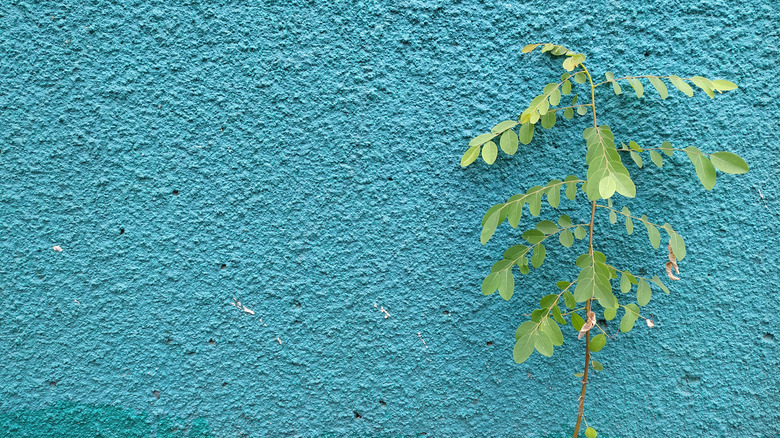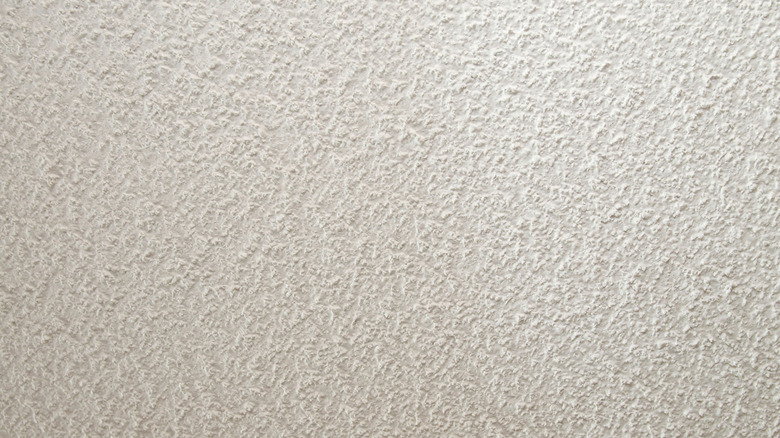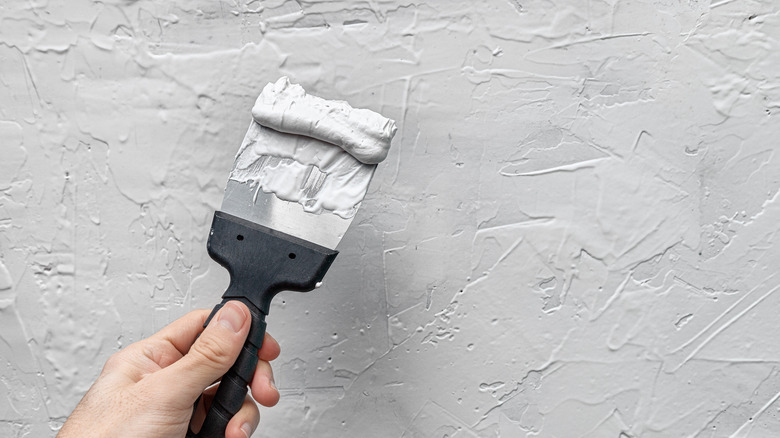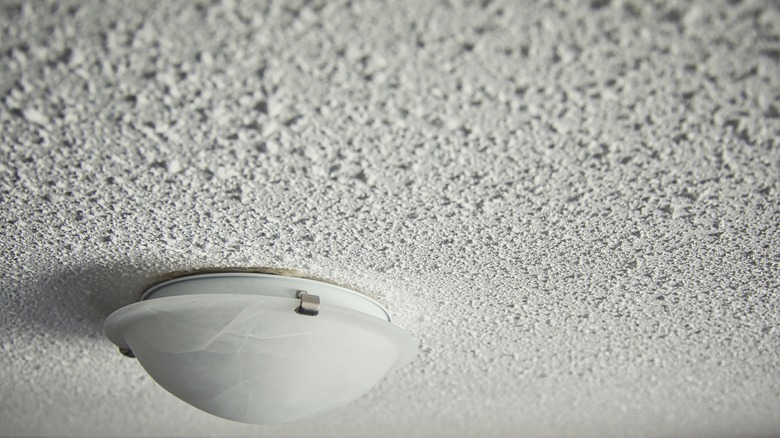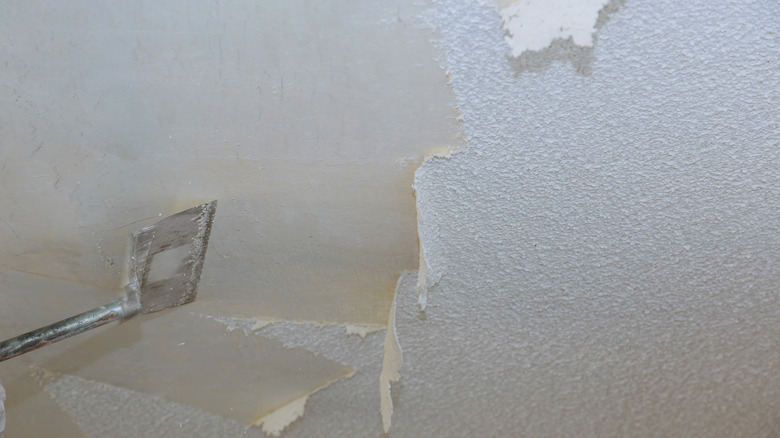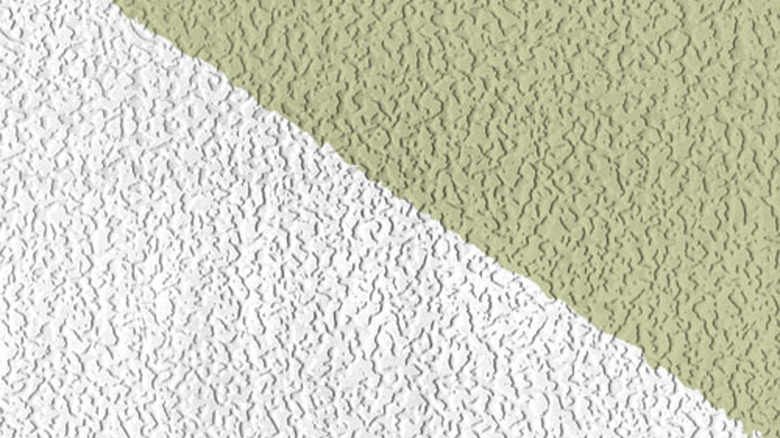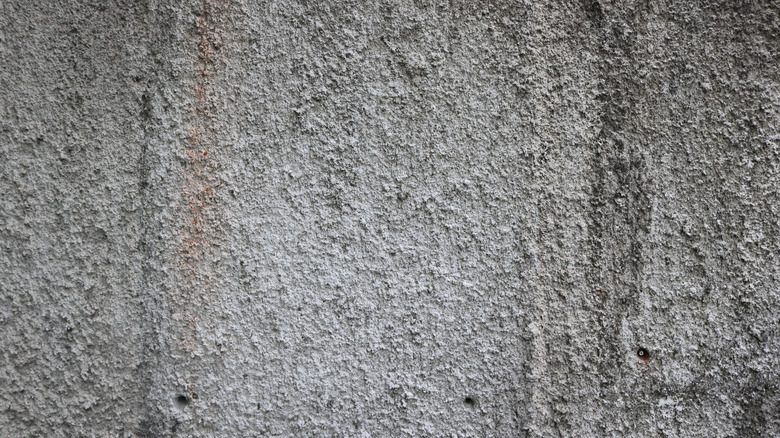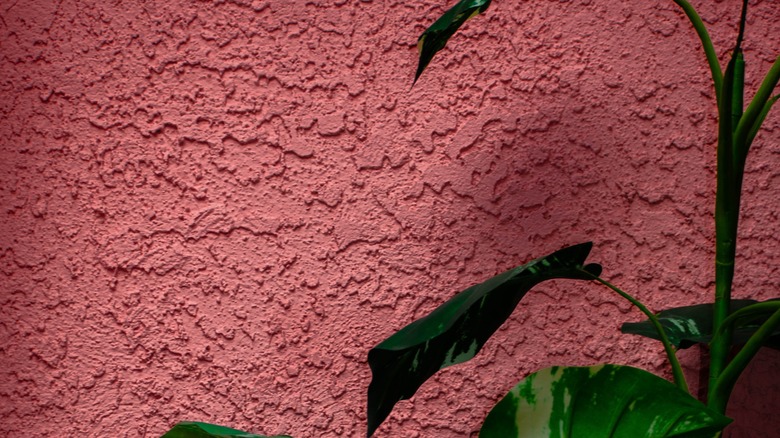Popcorn Walls Vs. Orange Peel Walls: What's The Difference?
Wall texture is often thought of as the perfect way to add warmth and depth to your home, as well as just a great way to spruce up a boring room. Texturing can also assist disguise architectural flaws, saving you money on costly repairs by blending an uneven wall or ceiling into a pleasing composed pattern. Although there are so many different wall textures, some are more popular, whether that's for their aesthetic or easy application. According to Greenberg Design Gallery, some of the most common include popcorn walls and orange peel walls, both being wall composition types you probably either have in your home or have seen elsewhere.
The two share similarities but differ in certain aspects, such as the application process. As many wall textures can be hard to differentiate and choose from, we took these two, which are among the most popular ones, to break it down for you. So, for your needs, wants, and preferences: orange peel or popcorn? Let's help you choose!
How does their appearance differ?
The difference between these two finishes is subtle but still noticeable. On the one hand, we have the popcorn wall texture that, as you could have guessed by the name, resembles popcorn. Also known as stipple walls or acoustic, this often rough-looking texture is best described as a bumpy surface. It was popularized in the housing boom of the 1960s and is therefore still present today in many American homes. This, however, also means that it does feel and look a little dated.
On the other hand, the orange peel texture feels and looks smoother comparatively but isn't, really. So again, the name is a pretty good indicator of what it looks like. According to Design Ideas Guide, orange peel is one of the most popular wall textures out there. It is, in fact, a classic in a lot of homes and has been for years. Most people love its subtle, dimpled look that makes any room feel just a little more special.
How does their application differ?
This is where the two wall textures really diverge. You will quickly have a choice, depending on whether you are looking for a beginner-friendly do-it-yourself surface or a professional one and are willing to try something that might be more complicated and time-consuming. If you've never textured a wall, orange peel is the best choice since it's on the easier side. All you need to use it is a mixture of drywall compound and water, which you then apply by spraying or rolling over a clean, sanded, and primed wall.
If you are feeling up to a challenge, the popcorn wall texture is a bit more difficult to create and would rather be left to a professional, but it's still accessible as a DIY project if you're really ambitious. All you'll need is the texture, a hopper gun, and an air compressor. This finish is a dry mixture of drywall mud and polystyrene that comes in a typical white tint, so prime the wall or ceiling first. Although other wall textures require uniformity, popcorn doesn't, Drywall 101 notes, so feel free to spray more or less according to how you want the final result.
Recommended uses of each
Wall texture can be applied wherever you see fit for your home, but some spaces are more popular for particular surface types. For instance, orange peel is mostly found in larger areas like living rooms or kitchens instead of smaller spaces like bedrooms. Although modern homes rarely use it anymore, it is still largely present in commercial buildings and hotels, per Drywall 101, because it lends a bit of a rustic feel to a space. It could be a great wall texture option if you live in a farmhouse or have that kind of décor.
Orange peel is also never seen on ceilings, contrary to popcorn finish. Popcorn wall texture can sometimes be seen fully covering a room. It's often the case in music studios since this surface type has noise-canceling properties, making it perfect for those spaces. However, this wall texture is also very common in bedrooms. Although it might not add as much depth as the orange peel finish, it can give a room uniqueness and character.
Pros and cons of popcorn walls
Popcorn surface being as thick as it is, it's the perfect texture to cover up any cracks or wall damage. Additionally, as mentioned, this wall texture cancels out noise and enhances overall sound quality, according to Homescopes. Furthermore, a popcorn-style wall is also very affordable and can be done by a courageous DIYer. Finally, it easily adds personality to a room and does most of the wall decoration by just being there.
Popcorn wall texture has two main cons, and the first is that it's a little outdated. But that being said, to each their own! Second, it's pretty hard to remove. The latter is why most homes built in the 1960s still have it since the new owners are probably not looking to give themselves a hard time by removing it. Lastly, two relatively small disadvantages are that popcorn walls easily attract dust and, due to the texture, are also pretty hard to paint.
Pros and cons of orange peel walls
Just like the popcorn wall texture, orange peel is an ideal way to hide any imperfections on your walls. However, this finish is a little more subtle and will blend nicely with almost any décor, including more modern designs, per Homax, which isn't the case with popcorn walls. Other advantages include the fact that orange peel is very easy to DIY and requires little time to do. It's also inexpensive and easier to clean than the popcorn finish.
On the other hand, orange peel wall textures are hard to match, meaning that the final outcome will depend on lots of different factors like the consistency of the mud, ambient temperature, humidity levels, and air pressure. This makes it hard to retouch an area or create an orange peel texture on an adjacent wall later since the factors will change, and as a result, so will the outcome.
Durability and maintenance
Popcorn texture walls can be considered durable for the simple reason that they are hard to get rid of. However, over time, stipple walls can become outdated, and once they do, you have to go through the strenuous task of getting rid of them. In terms of maintenance, popcorn walls need regular cleaning, more so than standard walls or other wall textures, since dust can easily accumulate in all the different nooks, Real Simple notes.
On the other hand, orange peel does not require particular maintenance since it has less relief than the popcorn finish. However, it is easier to keep around for years since its subtleness makes it hard for it to go out of style. In addition, it goes with different types of décor and, therefore, is easy to just leave it be even after drastic interior design changes. Odds are you'll keep this one around for a long time.
Why should you pick one over the other?
So now, how do you choose one rather than the other? While popcorn ceilings were a popular style in the 1960 and the 1970s, they can still be found in many homes today. So, if your home décor is more on the vintage side or has a romantic style, you'll want to go with popcorn texture walls, per Decor Tips.
However, if you have a more contemporary style home but would like to add some warmth and character to an otherwise pretty cold room, orange peel walls are the perfect addition. Moreover, if you tend the get tired of certain styles easily and like to change your décor often, orange peel finishes are easier to get rid of than the popcorn finish. Contrary to popular belief, many interior designers consider these techniques an excellent way to add complexity to walls, so it basically all depends on whether you like it or not, and how often you'd like to change your walls.
